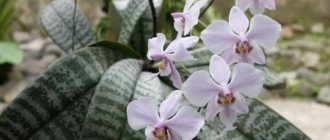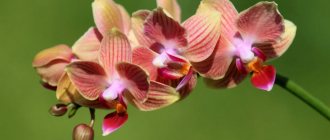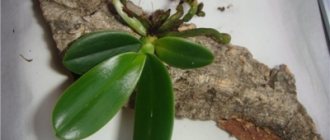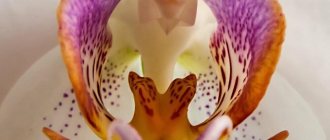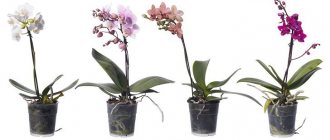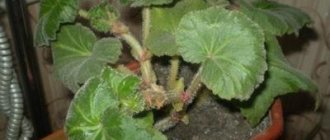The root system of an orchid is different from the roots of other plants. As a rule, its type depends on the type of nutrition of the orchid - whether the flower is an epiphyte, lithophyte or liana.
Epiphytic orchids have aerial roots that can absorb nutrients from the air, lithophytes feed from the soil, and vines envelop tree trunks, while feeding from the soil in the same way as lithophytes.
The roots determine the optimal care system for orchids, which ensures that the plant feels as comfortable as possible. You will learn about the roots of an orchid, how to care for the root system of orchids, and what diseases it is susceptible to in this article.
Root structure
The root system of epiphytic orchid types is characterized by considerable thickness.
The top layer of roots is called rhizoderm and it is in it that active (osmotic) absorption of moisture from the environment surrounding the root occurs.
The rhizoderm of the roots of most orchid species has a slightly different structure - these cells are dead and unsuitable for osmotic absorption; moisture here moves through capillaries. In appearance, this layer resembles a porous sponge and is called velamen .
The axial cylinder is the central part of the root that conducts water. This living tissue is like a water pipe that transports water and salts dissolved in it to the stem and leaves of the orchid. The axial cylinder is covered with parenchyma .
Parenchyma is the main part of the root that provides the function of the root and absorbs water. The parenchyma is covered with a membrane, velamen.
Velamen is several layers of dead cells, empty inside, which are formed during cycles of moistening and drying, a thin layer of 0.5-1 mm.
These cells are hollow inside and provide the cellular structure of the velamen. The empty cells of dry velamen are filled with air; when water gets on the velamen, the cells are passively filled with water, the velamen gets wet like a sponge, but it is not capable of transporting water, it only lets liquid into the root.
When the orchid's roots are dry , the velamen becomes rigid and does not allow moisture to leave the plant.
Velomen not only absorbs liquid inside, but also protects the root rod from damage. Having absorbed moisture, it becomes very flexible and pliable; it can bend well without violating the integrity of the covering material.
Immediately behind the velamen there is another layer - exodermis , its cells are heterogeneous.
This structure of orchid roots allows them to survive in conditions of moisture deficiency and lack of soil. In fact, the parenchyma is the “soil” in which the orchid’s roots grow.
For successful functioning, the root must alternately be filled with moisture and completely dry, blown with air, and illuminated by the sun.
Some deviations from ideal conditions can be successfully tolerated by the plant, but systematic disturbances will ultimately lead to the death of the entire root or, as happens more often, only the parenchyma and velamen.
On the roots of orchids there are waiting buds - meristems , which begin to grow if the root system is injured. There are also buds that are located at the base of the plant and begin to grow at the moment when the flower has lost its roots due to improperly organized care.
monopodial orchids are formed along the entire shoot (phalaenopsis, vanda).
The roots of sympodial orchids have rhizomes or pseudobulbs (Cattleya, Miltonia, Oncidium, Dendrobium).
The root system of lithophytic orchids is similar to other indoor plants. The main difference is that orchids are able to not only absorb moisture with their roots, but also store nutrients.
There are a number of lithophytic orchids in which the functions of the roots are performed by some semblance of nodules. Such parts of the plant take an active part in the process of feeding the indoor orchid in winter.
In Paphiopedilum, the roots are different and have a color from yellow to light brown, covered with a skin with light hairs, through which water is absorbed into the roots.
Types of root systems
Epiphytes, lithophytes and even vines grow well at home.
In lithophytes, the roots are brown, velvety to the touch and covered with many hairs. When growing orchids with such roots, it is important that most of the roots are in the growing container. The soil should be loose and light, and the flowerpot should provide active drainage. The most popular home orchids with this type of root system are plants of the Lady's slipper type.
The roots of epiphytic orchids have a different structure, since most of them grow outside the substrate. They are usually called airborne. Since epiphytes hardly take root in the soil, their roots have a different nutritional system - they receive all useful substances from litter, and moisture from the air. Thus, the roots of epiphytes do not need root hairs; they are covered with a special substance - velamen. Velamen consists of keratinized cells that form a porous coating that can retain moisture and nutrients for a long time.
Functions of roots
A healthy orchid root performs several important functions :
- transport, absorption and storage of water and minerals;
- fixing the orchid in the substrate and on the block;
- photosynthesis;
- gas exchange.
this complex system to function normally, it must be in balance, which is provided to it by environmental factors, the main of which is light .
How does an orchid absorb water?
Under the influence of light, moisture evaporates from the entire surface of the leaves. The roots receive a “request” to transport water to the leaves.
The process of active transport begins - the cells of the axial cylinder “capture” water molecules from the velamen and further move them from cell to cell through the cell membrane. This process is called osmosis .
Velamen gradually dries out. After complete drying, the new layer of cells dies and the velamen becomes thicker.
Fixation
Orchids grow in the wild on trees, rocks and other surfaces. At the same time, plants are often exposed to heavy rains and winds; it is the roots that help the orchid to gain a good foothold on any surface.
In the natural environment, roots can reach several meters and literally stick to any surface. Surely when replanting you encountered such a problem as roots stuck to the pot?
In order not to injure should be watered before replanting ; the roots will become elastic and more pliable for manipulation.
Gas exchange
The roots of epiphytic plants exchange gases: they take in oxygen and give up carbon.
To plant orchids, you need to use only breathable mixtures or bark of different fractions to ensure a sufficient amount of air around the roots.
Photosynthesis
It is important to understand that in orchids two processes simultaneously - this is respiration , in which oxygen is consumed (the orchid breathes day and night constantly and equally) and photosynthesis , in which carbon dioxide (CO2) is absorbed: the plant takes in carbon (C), and oxygen (O2) is released into the air. The release occurs only in the light.
It is very important to provide the orchids with good lighting , but do not forget to turn off the lamps at night if the plants are developing under artificial light.
How to care at home?
Despite the reliable velamen protection, orchid roots are very sensitive and require special care. However, knowing about the characteristics of the root system of these plants, it will not be difficult to create the necessary conditions:
- First of all, orchid roots need constant air circulation - even those that are in the substrate.
That is why orchids should never be planted in ordinary soil - the root system will not be able to “breathe” in it. Only a loose wood substrate is suitable for them, which also should not be too dense. It is also advisable to make ventilation holes in the walls of the pot. - Orchid roots cannot absorb water from the substrate - the velamen layer is not suitable for osmotic processes and can only absorb water deposited directly on it.
Therefore, aerial roots must be moistened periodically. There are many ways to water orchids, but the most common is to place the plant pot in warm water for about half an hour. - You should not water or “bathe” the orchid too often - the root system of this plant is easily susceptible to rotting. After each watering, it is necessary to allow the substrate to dry - depending on the composition of the substrate, this process can take from two days to two weeks.
What are pupated and pupated orchid roots?
During the year, orchids can either actively grow and develop, or stand still without showing signs of active growth. This often depends on the type of orchid.
You can determine which phase an orchid is in by its roots.
The actively growing tip of the root is green or light purple (depending on the pigment of the flowers), pointed, like a sharpened pencil.
Approximately 1-2 cm from the tip there is a velamen and the color of the root becomes silver. Such roots are called unpunched .
If the tip of the root is silvery and not pointed, ending in a small green dot, this means that the root is not growing at this time. This happens if the orchid is resting or has stopped growing due to unfavorable conditions. Such a root is called pupated .
Due to the tip, root growth occurs. During growth, cell division occurs, so there is no velamen at the tip of the root, there are living cells filled with juice.
Flower
An orchid flower is formed from a peduncle that grows from a certain axil between the leaves and the trunk of the plant. The peduncle changes annually; indoors it grows in autumn or spring. If at some point the formation of a peduncle does not occur, this often means that the orchid does not have enough sun and light. The peduncle dries out after the flowers fall.
A distinctive feature of the phalaenopsis flower is its central symmetry, when the six parts of the flower are arranged in two circles. The flowers have a variety of shapes, ranging in size from 1 to 20 cm.
How to distinguish dry roots from healthy ones?
A healthy root is elastic, hard, sticks out and almost does not bend, tending to break. The color of dry velamen is determined by the presence of air in the cells - silver-gray.
After getting wet , when the cells are filled with water, the green bark of the axial cylinder shines through it, the velamen looks silvery-green .
Dried velamen is gray-brown in color, which does not change with watering; the roots feel as if they are empty inside, papery; velamen is easily removed from the core, like a stocking.
Pseudobulb
Bulbs are certain formations that are found only in orchids of the sympodial type. This is a reduced shoot that collects moisture and nutrients. The pseudobulb is the same, but is formed in an ovoid, oval, cylindrical shape, while the bulb resembles an onion. Despite the fact that these formations are not shoots of the plant, sometimes buds, leaves and even aerial roots appear on them.
How to distinguish a rotten root from a healthy one?
This can be judged by the appearance of the roots and the condition of the entire plant.
A healthy root has a smooth surface, gray-silver color before watering and green after.
The rotting root first of all changes color to brownish-brown, then shrivels and after watering nothing changes at all.
If the pot is not transparent or the roots are not visible near the walls of the pot, signs of a problem with the roots can be noticed much later, when most of the roots have already been damaged and cannot perform their functions:
- does not bring water;
- does not fix the orchid.
If, with a damp substrate, the orchid loses turgor and wrinkles the leaves , and watering does not correct the situation, and the plant wobbles in the pot or threatens to fall out, then most likely there are almost no healthy roots.
To finally make sure of this, we remove the orchid from the pot, inspect and feel the roots. A healthy root is elastic, hard, sticks out and almost does not bend, and after getting wet it becomes only slightly more elastic.
Rotten roots are dark brown; under your fingers, the velamen breaks apart and falls off, exposing an axial cylinder that looks like a wire. Sometimes there is an unpleasant odor.
Other Possible Problems
In addition to various infections, the orchid can suffer due to improper care, too cold wintering or excess sunlight.
Green spots and dark spots on flowers
The reason for the appearance of green and dark spots on orchid flowers is the ingress of a large amount of moisture during watering, as well as mechanical damage. Subsequently, such spots dry out and have uneven edges.
Sometimes spots and dark spots are formed as a result of the development of a fungal infection, such as gray rot. In such cases, flowers and buds are completely affected within 24 hours. To eliminate the problem, they resort to treatment with an antifungal drug.
Brown and other spots on leaves
Brown spots indicate a fungal infection. In this case, the plant is quarantined and treated with antifungal drugs. Prevention involves providing the plant with suitable conditions for growth and development, allowing it to maintain its immune system.
Read more about what diseases occur on orchid leaves, how to recognize and treat them here.
Sticky drops
The causes of sticky drops on orchid leaves are:
- presence of pests: scale insects, whiteflies, scale insects;
- improper maintenance conditions: excess fertilizer applied, high air humidity, excessive watering.
If harmful insects are detected, the plant is treated with an insecticide. In case of violation of the conditions of detention, treatment consists of following the rules of agricultural technology.
Burns
An epiphyte getting a burn is caused by:
- being under the scorching rays of the sun;
- spraying in the sun.
In this case, the flower is immediately removed into the shade, and subsequently protected from direct sunlight.
Useful video
Growing orchid roots on moss
This is a universal method that is used both for growing roots in phalaenopsis after pruning, and for stimulating the formation of shoots in children. But it is not suitable for every flower. If the plant has lost all its roots, technology will not help.
Orchid root extension



